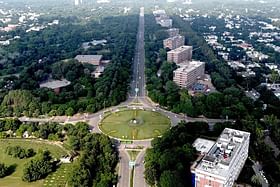The agency had put forward a proposal to address traffic congestion in the Tricity by a 39-km metro network that would cover Chandigarh, Mohali, and Panchkula.
In April this year, Chandigarh, Haryana and Punjab accorded in-principal approval to the CMP for the Tricity.
The final metro network will be developed in two phases.
The Tricity metro project has received the green signal from the Union ministry of Housing and Urban Affairs — one month after the comprehensive mobility plan (CMP) was submitted for approvals.
A senior UT official said, “We have got a nod from the ministry, stating that they do not have any objection to the project. The ministry had asked the Rail India Technical and Economic Services (RITES) to prepare a detailed project report (DPR) phase-wise, which will be again sent to the ministry for funds”, reports Hindustan Times.
The agency had put forward a proposal to address traffic congestion in the Tricity by a 39-km metro network that would cover Chandigarh, Mohali, and Panchkula, as part its CMP.
The mass rapid transport system (MRTS) is expected to cost over Rs 10,570 crore and will also include bus terminals, depots and improvements at busy intersections.
In April this year, Chandigarh, Haryana and Punjab accorded in-principal approval to the CMP for the Tricity.
The proposed plan was approved with some suggested additions for the metro transit system by the Punjab and Haryana governments.
Chandigarh, Mohali, Panchkula, Zirakpur, New Chandigarh and Pinjore will be covered by the final metro network, which will be developed in two phases.
In the first phase — scheduled to be developed between 2027 and 2037 — the MRTS will run from Sarangpur to Panchkula ISBT, Rock Garden to Zirakpur ISBT via Mohali Industrial Area and airport, and from Grain Market Chowk, Sector 39, to Transport Nagar, Sector 26.
The second phase — which will be developed after 2037 — will cover four routes: Panchkula ISBT to Panchkula Extension, Paraul, New Chandigarh to Sarangpur, Airport Chowk to Manakpur Kallar, and Zirakpur ISBT to Pinjore ISBT, as per HT report.
In addition, the UT administration has finalised seven straight bus corridors that criss-cross through the tricity — to encourage more people to switch to public transport and ensure smooth traffic flow, in line with RITES’ proposal for a robust local bus network.
The CMP readied by RITES has been divided into short, medium and long-term transport improvement proposals.
The report focuses on improving parking management, junctions, pedestrian infrastructure, road infrastructure, local bus system, intermodal interchanges and integrated freight complexes.


